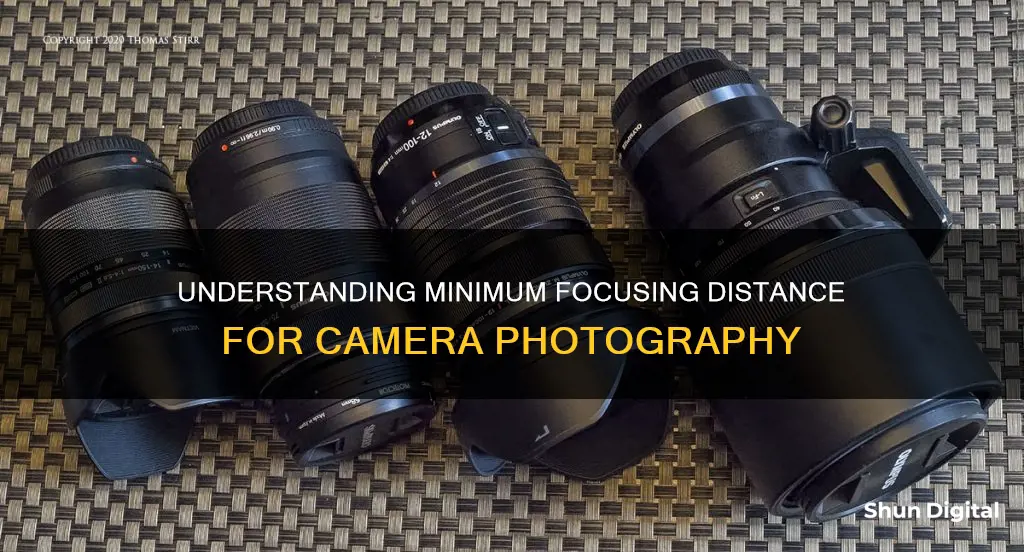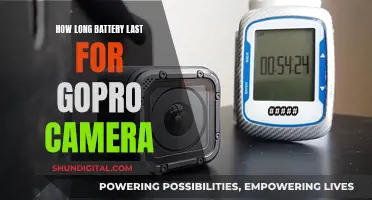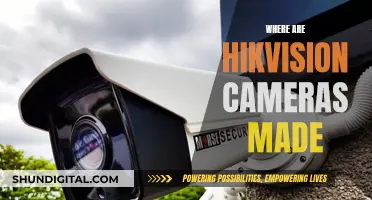
The minimum focusing distance of a camera is the shortest distance required to get a clear shot of your subject. It is the distance from the focusing plane (where the camera's sensor is) to the subject. If you get closer to the subject than the minimum focusing distance, your camera will have trouble focusing, and you won't be able to capture a well-focused image. The minimum focusing distance varies depending on the lens and the focal length. Macro lenses, for example, are designed for close-up photography and have a minimum focusing distance that allows you to get very close to your subject.
| Characteristics | Values |
|---|---|
| Definition | The shortest distance from the focusing plane to the subject at which the subject can be sharply rendered. |
| Other names | Closest focusing distance |
| Measurement | Measured from the camera's sensor to the subject. |
| Impact | If you get closer to the subject than the minimum focusing distance, you cannot focus on the subject properly. |
| Variance | The minimum focusing distance varies by lens; in zoom lenses, it can also vary depending on focal lengths. |
What You'll Learn

Minimum focusing distance varies from lens to lens
The minimum focusing distance of a camera lens is the shortest distance that the lens can be from the subject and still have the subject in focus. This distance varies from lens to lens and is influenced by several factors.
Firstly, different lenses have varying constructions and capabilities. For example, macro lenses are designed to focus at much closer distances compared to standard lenses as they are optimised for close-up photography. The focal length of a lens also affects its minimum focusing distance. Lenses with longer focal lengths tend to have longer minimum focusing distances, and telephoto lenses often have longer minimum focusing distances compared to wide-angle or standard lenses.
Secondly, the internal structure and mechanisms of the lens play a role. Some lenses have a floating element design or internal focusing mechanisms that enable them to focus at very close distances. The camera system itself also influences the minimum focusing distance. The distance between the lens mount and the sensor or film in the camera body can impact the lens's ability to focus at close ranges.
It is important to understand the minimum focusing distance of a lens, especially for photographers interested in macro or close-up photography. It allows them to determine the closest distance from which they can capture sharp and detailed images. For instance, in situations where one wants to get as close as possible to the subject, such as when taking close-ups of flowers, knowing the minimum focusing distance can help photographers find the optimal distance for a clear shot.
Additionally, the minimum focusing distance is crucial when using long telephoto lenses for nature and bird photography. Photographers may encounter subjects positioned inside the minimum focusing distance of their telephoto lens, requiring them to adjust their position or miss the shot. In such cases, carrying extension tubes can help shorten the minimum focusing distance and capture the desired image.
Eufy Camera Battery Life: How Long Do They Last?
You may want to see also

The distance is measured from the camera's sensor to the subject
The minimum focusing distance is the shortest distance you can be from your subject while still maintaining focus. This distance varies from lens to lens, and it is an important factor to consider when investing in a new lens, especially if you do a lot of close-up photography or intend to use extension tubes.
The minimum focusing distance is measured from the camera's sensor to the subject. Most camera bodies have a symbol of a circle with a line through it to indicate the location of the sensor, and this is where the measurement begins. This means that the minimum focusing distance is not the distance from the front of the lens to the subject, as some might assume.
For example, the Nikon 60mm macro lens has a minimum focusing distance of 18.5cm. This is measured from the camera's sensor to the subject, so when the lens is focused at this distance, the front of the lens is actually less than 4cm away from the subject. This can make it difficult to approach insects or other living subjects without casting a shadow on them or blocking the light.
Understanding the minimum focusing distance of your lens is crucial, especially when using long telephoto lenses for nature or bird photography. If the subject is positioned inside the minimum focusing distance of the lens, the photographer may need to back away or miss the shot.
To master the minimum focusing distance of your camera, check the specifications and memorise this distance. This will help you get comfortable shooting at specific distances and ensure you get clear, crisp photos.
Garry's Mod Camera Mode: A Step-by-Step Guide
You may want to see also

It is important to consider when investing in a new lens
The minimum focusing distance of a camera is the shortest distance you can be from your subject and still have it in focus. This distance varies from lens to lens and is important to consider when investing in a new lens. Here are some reasons why:
- The versatility of your photography: If you intend to do a lot of close-up work or macro photography, a shorter minimum focusing distance will be important. It will allow you to get closer to your subject and capture finer details. This is especially useful for nature and bird photography, where you may not be able to get very close to your subject.
- Working distance from your subject: The minimum focusing distance affects how close you need to be to your subject to get a clear shot. For example, if you are photographing insects or skittish subjects, a shorter minimum focusing distance may be preferable as it gives you more working distance. With a longer minimum focusing distance, you may need to get too close, potentially disturbing or casting a shadow on your subject.
- Image quality: Using extension tubes to shorten the minimum focusing distance can sometimes cause image quality issues, especially with modern lenses that have 'floating elements'. Understanding the minimum focusing distance of your lens can help you avoid such problems and get the best image quality.
- Composition and framing: The minimum focusing distance can impact the composition and framing of your images. A longer minimum focusing distance may require you to zoom out, resulting in a smaller subject in your frame. Conversely, a shorter minimum focusing distance can allow you to fill the frame with your subject, capturing more detail.
- Practical considerations: In some situations, you may not have the space to move back to achieve focus. For example, if you are on a park bench and a rare butterfly lands next to you, a lens with a longer minimum focusing distance may not be able to focus on the subject without you moving back. Understanding the minimum focusing distance of your lens can help you be prepared for such situations.
In conclusion, while there are many important factors to consider when investing in a new lens, the minimum focusing distance should not be overlooked. It can significantly impact the type of photography you can do, the quality of your images, and your overall photographic experience.
Reolink Camera Battery Options: What's Your Best Pick?
You may want to see also

It can be overcome by using extension tubes
The minimum focusing distance of a camera is the shortest distance you can be from your subject while still having your subject in focus. This distance varies from lens to lens. If you are unable to frame the shot you want because you can't get close enough to focus, you may want to consider using extension tubes.
Extension tubes are spacers that sit between your lens and the camera body to alter the minimum focus distance. They get the lens further away from the focal plane, allowing you to get closer to your subject and fill the frame with more of it. The thicker the extension tube, the higher the lens magnification as you are able to move the lens closer to the subject while still achieving focus.
Extension tubes are a cost-effective way to get the kind of short focusing distances that you get from a dedicated and much more expensive macro lens. They are small, lightweight, and easy to carry around. They are also useful if you want to get into macro photography without committing to a macro lens.
However, there are some disadvantages to using extension tubes. They can decrease your maximum focus distance, meaning you will no longer be able to focus at infinity. They can also cause vignetting when used on lenses that are set at, or close to, their widest aperture. Additionally, they can decrease the effective f-stop of the lens, resulting in a darker image and a shallower depth of field.
Despite these drawbacks, extension tubes can be a great tool for photographers who want to get closer to their subjects without investing in a dedicated macro lens.
The Evolution of Polaroid: 103 Land Camera's Debut
You may want to see also

It is important when using long telephoto lenses
The minimum focusing distance of a lens is the shortest distance you can be from your subject while still keeping it in focus. This distance varies from lens to lens and is an important factor when investing in a new lens. It is particularly important when using long telephoto lenses for nature and bird photography. For example, a butterfly may land next to you and, if you are unable to move away, your lens's minimum focusing distance may be greater than the distance to the butterfly, causing you to miss your shot.
Telephoto lenses have a focal length longer than the diagonal size of the image they take. They are used to make far-away objects appear closer to the camera. They can be zoom lenses, such as 70-300mm, or prime lenses, such as 200mm. Due to the number of pieces of glass inside, they are often large, heavy, and expensive.
Telephoto lenses can be divided into three categories based on focal length: short telephoto, medium telephoto, and super-telephoto. Short telephoto lenses range from 85mm to 135mm and are great for everyday use due to their compact size and lightweight design. Medium telephoto lenses offer focal lengths between 135mm and 300mm, making them bigger, longer, and heavier. Super-telephoto lenses have focal lengths beyond 300mm and offer telescope-like magnification, making them too heavy for handheld shooting.
When using a telephoto lens, it is important to consider the minimum focusing distance to ensure you can get the shot you want. This is especially true when photographing subjects that are close to the lens, such as insects or flowers. By understanding the minimum focusing distance of your lens, you can avoid moving too close to your subject and missing the shot. Additionally, using extension tubes can help shorten the minimum focusing distance of your lens, providing more flexibility in your photography.
Unlocking Portrait Mode: Capturing Professional Photos on Your Mobile
You may want to see also
Frequently asked questions
The minimum focusing distance is the shortest distance required between the camera and the subject to get a clear shot of the subject.
Minimum focusing distance is important because it determines how close you can get to your subject and still get a clear shot. This is especially important for close-up work or when using long telephoto lenses for nature and bird photography.
The minimum focusing distance is usually indicated on the front side of the lens in meters (m) and feet (ft). You can also find it in the lens specifications.
If you get closer to your subject than the minimum focusing distance, your camera will have a hard time focusing and you won't be able to get a clear shot.
One way to get clear shots of subjects that are closer than the minimum focusing distance is to use extension tubes with your lens. This can shorten the minimum focusing distance and allow you to get closer to your subject.







